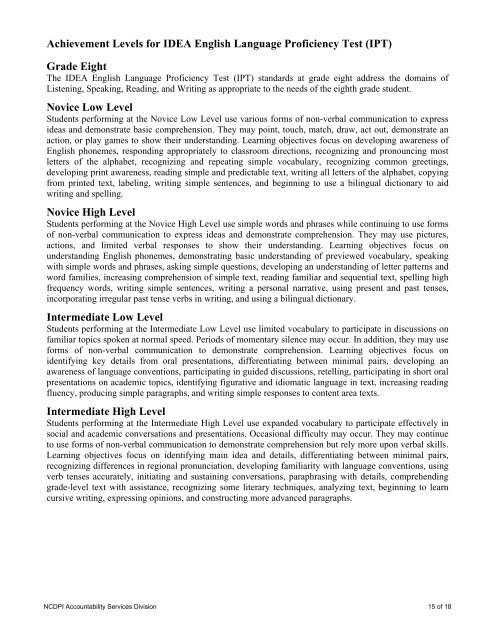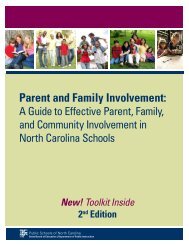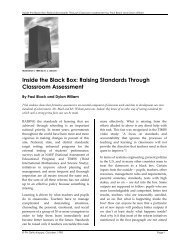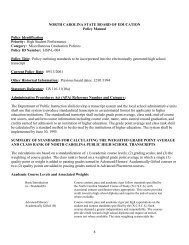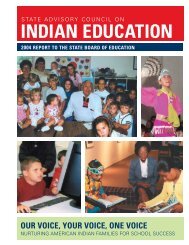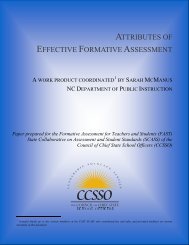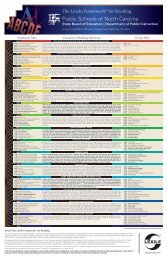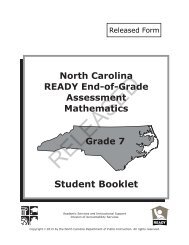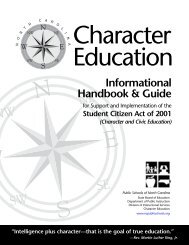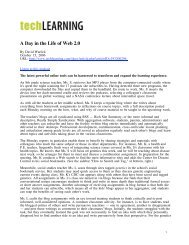Achievement Levels for IDEA English Language Proficiency Test (IPT)
Achievement Levels for IDEA English Language Proficiency Test (IPT)
Achievement Levels for IDEA English Language Proficiency Test (IPT)
Create successful ePaper yourself
Turn your PDF publications into a flip-book with our unique Google optimized e-Paper software.
<strong>Achievement</strong> <strong>Levels</strong> <strong>for</strong> <strong>IDEA</strong> <strong>English</strong> <strong>Language</strong> <strong>Proficiency</strong> <strong>Test</strong> (<strong>IPT</strong>)<br />
Grade Eight<br />
The <strong>IDEA</strong> <strong>English</strong> <strong>Language</strong> <strong>Proficiency</strong> <strong>Test</strong> (<strong>IPT</strong>) standards at grade eight address the domains of<br />
Listening, Speaking, Reading, and Writing as appropriate to the needs of the eighth grade student.<br />
Novice Low Level<br />
Students per<strong>for</strong>ming at the Novice Low Level use various <strong>for</strong>ms of non-verbal communication to express<br />
ideas and demonstrate basic comprehension. They may point, touch, match, draw, act out, demonstrate an<br />
action, or play games to show their understanding. Learning objectives focus on developing awareness of<br />
<strong>English</strong> phonemes, responding appropriately to classroom directions, recognizing and pronouncing most<br />
letters of the alphabet, recognizing and repeating simple vocabulary, recognizing common greetings,<br />
developing print awareness, reading simple and predictable text, writing all letters of the alphabet, copying<br />
from printed text, labeling, writing simple sentences, and beginning to use a bilingual dictionary to aid<br />
writing and spelling.<br />
Novice High Level<br />
Students per<strong>for</strong>ming at the Novice High Level use simple words and phrases while continuing to use <strong>for</strong>ms<br />
of non-verbal communication to express ideas and demonstrate comprehension. They may use pictures,<br />
actions, and limited verbal responses to show their understanding. Learning objectives focus on<br />
understanding <strong>English</strong> phonemes, demonstrating basic understanding of previewed vocabulary, speaking<br />
with simple words and phrases, asking simple questions, developing an understanding of letter patterns and<br />
word families, increasing comprehension of simple text, reading familiar and sequential text, spelling high<br />
frequency words, writing simple sentences, writing a personal narrative, using present and past tenses,<br />
incorporating irregular past tense verbs in writing, and using a bilingual dictionary.<br />
Intermediate Low Level<br />
Students per<strong>for</strong>ming at the Intermediate Low Level use limited vocabulary to participate in discussions on<br />
familiar topics spoken at normal speed. Periods of momentary silence may occur. In addition, they may use<br />
<strong>for</strong>ms of non-verbal communication to demonstrate comprehension. Learning objectives focus on<br />
identifying key details from oral presentations, differentiating between minimal pairs, developing an<br />
awareness of language conventions, participating in guided discussions, retelling, participating in short oral<br />
presentations on academic topics, identifying figurative and idiomatic language in text, increasing reading<br />
fluency, producing simple paragraphs, and writing simple responses to content area texts.<br />
Intermediate High Level<br />
Students per<strong>for</strong>ming at the Intermediate High Level use expanded vocabulary to participate effectively in<br />
social and academic conversations and presentations. Occasional difficulty may occur. They may continue<br />
to use <strong>for</strong>ms of non-verbal communication to demonstrate comprehension but rely more upon verbal skills.<br />
Learning objectives focus on identifying main idea and details, differentiating between minimal pairs,<br />
recognizing differences in regional pronunciation, developing familiarity with language conventions, using<br />
verb tenses accurately, initiating and sustaining conversations, paraphrasing with details, comprehending<br />
grade-level text with assistance, recognizing some literary techniques, analyzing text, beginning to learn<br />
cursive writing, expressing opinions, and constructing more advanced paragraphs.<br />
NCDPI Accountability Services Division 15 of 18


